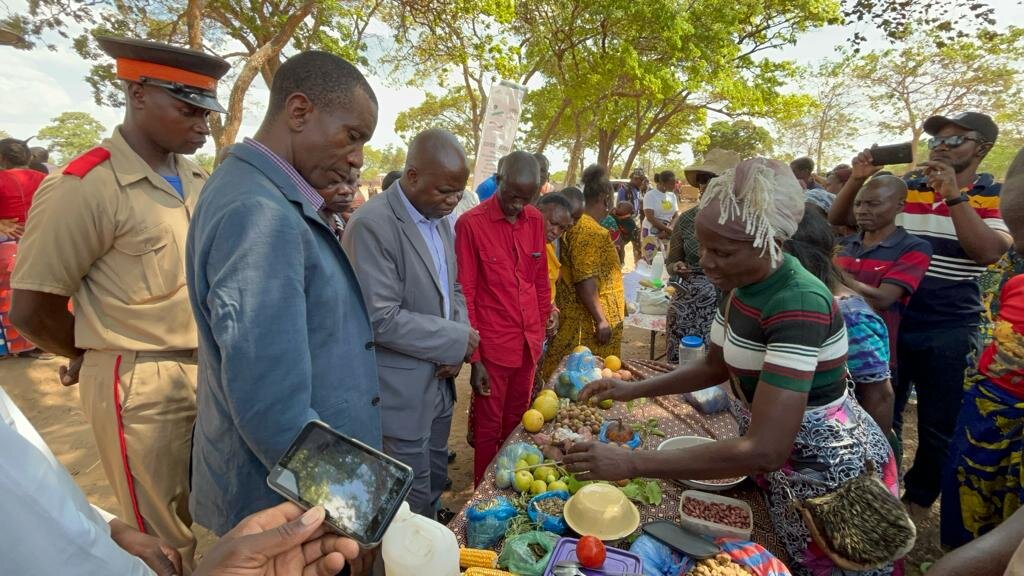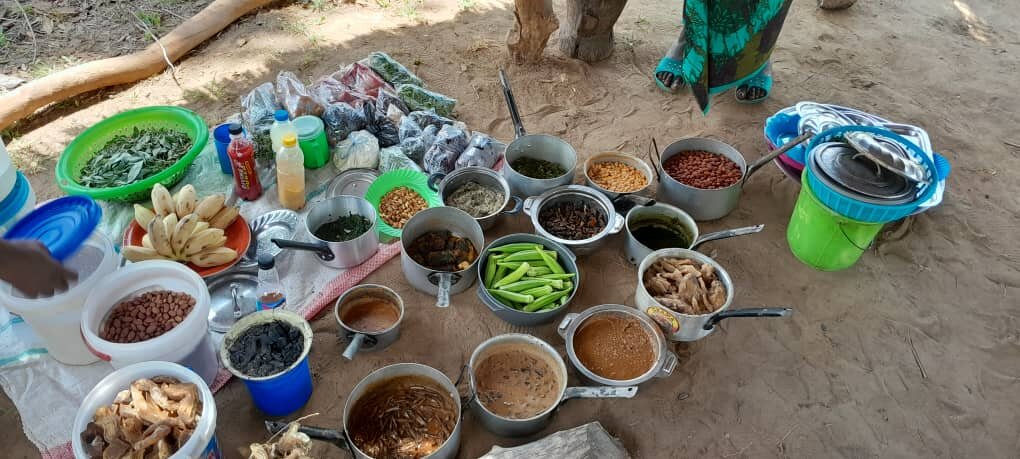By Lydia Amanzi | Communications officer
I might never know how a school teacher feels to see their student grasp the concept of a lesson. However, I felt something close to that recently in Magodi in Eastern Zambia when a few elderly women my mother's age and even older were dancing and leaping with joy after learning that their families were poised to be better nourished. This was at the end of a two day training for 20 Community Health Volunteers who then each trained 35 Household Care Givers in nutrition.
The chiefdoms include Mwape, Nyanje, Magodi and Chikomeni situated in Eastern Zambia; Chibale and Chitambo in Central Zambia; and Mukungule and Chikwanda in Muchinga in Northeast Zambia.
In Chasefu district in Chikomeni Chiefdom, women erupted into a praise song that celebrated the deliciousness and nutritional richness of local dishes that containedwild foods. “This is so sweet! The taste! So nice! All the six food groups!” they sang. This song described the rich benefits of the wild foods and fruit portfolios in their village about which they had learnt. The women delighted all who looked on.
In Nyanje chiefdom, the community members engaged in debates that were designed to verify whether they grasped the six food groups. It was a memorable sight to behold as they encouraged each other on the concepts of nutrition that they were learning.
During a “food fair” in Nyanje chiefdom, a moment unfolded when Belinda Shula, a nutritionist and the lead facilitator of the training, pointed to food that a participant was eating. She asked, “What food group is this?” Without much thought, the gentleman confidently replied “It's cereal”. However, as soon as he responded, his colleague chimed in - “It’s a legume,” and they both chuckled in agreement. This type of peer learning fostered a sense of ownership among the participants, making it easier for them to assimilate the knowledge they were gaining.
A food fair is a gathering that celebrates and promotes foods, focusing on local cuisine, healthy eating, and nutritional awareness. It includes cooking demos, food tastings, and educational activities. The event provides community members with the platform to learn about different foods, culinary traditions, and dietary practices, while also engaging with local producers and nutrition experts. Food fairs often involve entertainment, such as music and cultural performances, to create a lively and informative atmosphere for attendees.
One of pregnant women attending the food fair said she was now more confident that she would produce a healthy baby thanks to the training she had received from her local Community Health Volunteer.
“Since I am pregnant, I need to eat different types of foods so that my unborn child does not become stunted,” she said.
“Any examples? Do you eat these foods at home?” asked the trainer.
“Yes,” she responded quickly.
“So you are certain the baby will be born healthy?” the trainer pressed her.
“Yes, very healthy,” she said with certainty. “I eat vegetables, meat, Masuku, sweet potatoes, millet.”
Masuku (Uapaca kirkiana) is one of the important wild fruits identified by the project. It has always been a mainstay of rural diets in Zambia but insufficiently recognized for the many micronutrients its flesh contains.
There were other instances where participants incorrectly identified foods and their respective groups. For example, when asked by Belinda what he was eating, a male participant replied, "I am eating nshima made from millet." Belinda then asked "In which food group does millet fall under?" The participant initially said "legumes," but upon his friend's disapproving sound, he quickly reconsidered and agreed that it belonged to the cereal group.
Aside from the trainings, the food fairs also gave the communities a chance to learn about inclusion of wild foods into diets using “edutainment”, a term coined for a fun and entertaining way of learning using skits, poems, singing and dance-offs among the attendees and the local performers.
In three chiefdoms during the Community Health Volunteers and Household Care Givers trainings, nutrition quizzes were held, and prizes including soap were given to the winners to reinforce the Water Sanitation and Hygiene (WASH) element.
These food fairs also complemented the World Food Day commemoration on 16th October 2023 and the Africa Day of Food and Nutrition on 2nd November 2023.
The food and nutrition fairs were held in each chiefdom between 25 October and 10 November 2023. They rode on the overall objective to “deliver general nutrition trainings/awareness creation outreach to selected caregivers/ participating households”. More specifically, this event was held to: 1) complement and reinforce the nutrition training of caregivers (milestone 3a), 2) reach more people with nutrition messages, and 3) showcase the utilization of wild foods and other locally available foods through cooking demonstrations and food tasting by the public.
The District Commissioners (DCs), Chiefs, and other traditional leaders were invited to grace the food and nutrition fairs. Their participation stirred the communities’ interest in the event and raised its profile. Moreover, it was also an opportunity for the DCs and traditional leadership to appreciate the significance of wild foods for dietary diversity and improved nutrition among their subjects.
In Nyanje chiefdom,the chief’s representative (senior Induna) was amazed at how tasty the foods were. He said he had not thought that foods grown in the chiefdom could be made to taste like food from Sinda town or Lusaka. He asked for written recipes for the dishes he enjoyed so that he could share them with his wife at home. These included cowpea sausage, pumpkin seeds and leaves, bambara nuts and cakes, and Mpundu porridge. Mpundu is the fruit of Parinari curatellifolia, a tree found in Zambia’s Miombo woodland.
It was motivating for participants to see their leaders embrace indigenous foods. Many got encouraged to try them. Importantly, it also made them realise that these foods were not a sign of poverty as assumed and debunked many theories. Finally, the training provided them another opportunity to be positive changemakers in nature conservation using fruit/food trees after having earned a living poaching wildlife.
We extend our heartfelt gratitude for your support of this project, and we kindly request that you continue to champion our cause by spreading the word among your friends and colleagues. We are maximizing the impact of our donors' funds to the best of our ability. Your contributions are deeply cherished and valued.
Through this initiative, step by step, rural communities can enhance their diets with the inclusion of wild foods that have long been undervalued and overlookedin family diets These wild foods now play a significant role in Zambia's nutrition strategy, marking a pivotal shift towards improved well-being for all.
Project reports on GlobalGiving are posted directly to globalgiving.org by Project Leaders as they are completed, generally every 3-4 months. To protect the integrity of these documents, GlobalGiving does not alter them; therefore you may find some language or formatting issues.
If you donate to this project or have donated to this project, you can receive an email when this project posts a report. You can also subscribe for reports without donating.
Support this important cause by creating a personalized fundraising page.
Start a Fundraiser
